|

fabrics
& sewing
sewing
tools
sewing
techniques
basic
medieval
clothing
sewing
tutorials
commercial
patterns &
what to do
about them
dyes
&
colours
fabric,
fur
& leather
names
embellishments
& embroidery
buttons
& lacings
|

Medieval
Sewing Tools
NEEDLES - PINS - THIMBLES - SCISSORS & SHEARS
- NEEDLECASES - REELS - IRONS
LUCETS - SPINDLES - SPINNING WHEELS - LOOMS
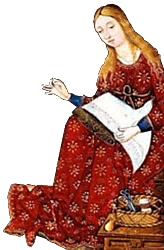
Sewing is an occupation which is usually the domain of women.
During the medieval period, guilds stipulated what women could
and could not produce commercially. On a domestic level, women
at home produced everything but professionally, some industries
were dominated by men.
The tools for basic sewing
have not changed over thousands of years. The shapes of some of
them- like scissors- have varied slightly, but pins and needles
and the way women use them, have not.
Sewing tools include: needles, pins, scissors, snips, shears,
thimbles, needlecases, pin cases, reels, awls, and lucets. All
of these items may be found in the modern woman's sewing basket.
The detail at right is from a 15th century illumination The
Holy Family and shows Mary with a basket of sewing tools.
The most comprehensive listing of sewing tools comes from Hugh
of St Victor when he talks about the tools required for textile
arts. Although he lived between 1096 and 1141, he cites:
Textile manufacture
includes all types of weaving, sewing, and spinning which
are done by hand, needle, spindle, awl, reel, comb, loom,
crisper, iron or any other kind of instrument out of any kind
of material of flax or wool, or any sort of skin, whether
scraped or hairy, also out of hemp or cork, or rushes or tufts
or anything of the kind which can be used for making clothes,
coverings, drapery, blankets, saddles, carpets, curtains,
napkins, felts, strings, nets, ropes; out of straw, too, from
which men usually make their hats and their baskets. All these
studies pertain to textile manufacture.

Sewing
needles
One of the most basic and long-lived of all the sewing tools is
the needle. Along with pins, needles have been used for garment
making since time immemorial.
In 1370, we find references to needle-making for sewing from Germany.
Prior to that, there are records of bookbinders and shoemakers
needles made from hog bristles.
Needles could be made from bronze, iron and bone, which was readily
available to poorer women. The needle at right is made of bronze
and dates between the 14th and 15 centuries. It was found at Threave
Castle, in Scotland.

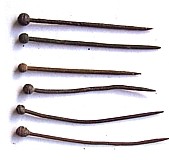 Pins Pins
Pins have been used for sewing and also as a dress accessory,
so many finds from archaeological digs have decorative ends with
glass beads.
It is likely that plain pins with smaller non-decorative heads
were used for pinning fabric together prior to sewing in the manner
which we do today.
Shown at left is a collection of brass, coil-headed pins found
at th foreshore in front of one of Henry VIII's palaces in Greenwich,
England.Tudor. They are dated to the 16th century.

 Thimbles Thimbles
Thimbles have also been used for centuries.
The dimples in the surface allowed the thimble to protect the
finger while pushing a needle through fabric or leather. A thimble
is generally made out of strong leather or metal, although some
older manufacturers used horn and ivory.
The large thimble to the left is an example of a brass, domed
thimble from my own collection. It has hand drilled holes and
dates to the 14th-15th century. The second thimble shown at the
right is also from London, England from the 14th century, also
both constructed from brass and has a small hole at the top which
may or may not have been acquired in the manufacturing process.
 The
silver thimble at the right is also from London, England and is
hand-punched. It is silver-gilt and bears an inscribed motto in
medieval French, "MA JO IE" which means my joy.
It also has engraved leaves. The
silver thimble at the right is also from London, England and is
hand-punched. It is silver-gilt and bears an inscribed motto in
medieval French, "MA JO IE" which means my joy.
It also has engraved leaves.  Such
in item would have been quite expensive and used for fine work
by a wealthy woman. Such
in item would have been quite expensive and used for fine work
by a wealthy woman.
The thimble at left is known
as a ring thimble because its design and open top lets
it be worn on the finger like a ring. It is made of brass and
dated to the 15th century England.
It comes from The
Gilbert Collection.

Scissors
and shears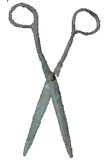
Another of the basic sewing tools which has survived almost unchanged
is scissors. Scissors proper and sprung shears have both been
found throughout the medieval period and although of varying design,
are much like the ones we have today . .
The scissors shown at right
are from the medieval period but the exact names and references
I have are in Russian so you may look at the pictures until I
find an English language translation, but I believe they are either
from the London finds or the Novrogod finds.
The one at left of the pair are from the same find and are almost
identical to the ones found in viking excavations and to the ones
we use today. They are commonly depicted in illuminations where
sheep shearing or the cutting of large bolts of cloth are shown.
 The
scissors shown below right date between 1350 and 1400. They are
made of iron and were found at Baynards Castle in England. They
are also very similar to scissors which have been produced in
the 20th century. The
scissors shown below right date between 1350 and 1400. They are
made of iron and were found at Baynards Castle in England. They
are also very similar to scissors which have been produced in
the 20th century.

  Needlecases
and pincases Needlecases
and pincases
What to keep one's small sewing tools in to save them getting
lost has long been a question faced by women from as long as they
had tools to use.
Needlecases and pincases during the medieval period were usually
more or less cylindrical with a top which lifted off but remained
attached via two cords, one at each side.
Many of these were made of metal and could be quite ornate although
there have been a few examples of worked leather as well.
The 13th century hexagonal
needlecase shown at near left is made from silver and has an ornate
pattern embossed into its sides. It would have belonged to a wealthy
woman. The needlecase shown at far left is dated from the 16th
century in Venice but it is typical of the style used in the preceeding
centuries.

 Bobbins,
reels and threadholders Bobbins,
reels and threadholders
Threadholders, bobbins and reels are another sewing item which
has barely changed shape over the centuries. The two most popular
shapes are long and thin, or shorter with a wide top and foot,
similar to the ones of our grandmothers era with or without the
hole at the top and bottom.
At the left is an example
of an existant wooden thread holder from London.

Irons
Most modern households have an iron but only the well-off medieval
woman might have an iron. Laundry accounts seem to mention some
specific services- darning and washing, but not others. It seems
that irons were used during the medieval period to flatten household
linens and clothing.
Some were made of ceramic, some of Italian soapstone and others
forged from iron by blacksmiths. In Textiles and Clothing
published by the Museum of London, it mentions linen smoothers
made from glass as being also known from the medieval period.
Among the comprehensive listing of sewing tools by Hugh of St
Victor who lived between1096-1141, is listed-
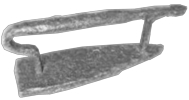 loom,
crisper, iron or any other kind of instrument out of any kind
of material... All ... pertain to textile manufacture. loom,
crisper, iron or any other kind of instrument out of any kind
of material... All ... pertain to textile manufacture.
The image at left is of a
15th century iron described as with a salamander shaped-handle
made from iron. It comes from the Allemoli Collection of
antique irons and is used here without permission. If it is your
iron, please contact me so I may seek your permission or have
the image removed.

Lucets
 The
lucet is a cord or lace-making tool which has been used since
Saxon times. By wrapping the thread around the prongs in a manner
similar to French knitting, a square braid or lace is produced. The
lucet is a cord or lace-making tool which has been used since
Saxon times. By wrapping the thread around the prongs in a manner
similar to French knitting, a square braid or lace is produced.
This lace is strong, durable and doesn't easily slip when used
for garment fastenings. As far as I can tell, there are no illustrations
of braid being made using a lucet (or lucette, in French) but
braid found matches that which could be made with a two-pronged
tool such as these shown here.
Shown at near left is an
item believed to be a bone lucet from York, in England. The decorated
item at the right is made from whale bone and generally believed
to be a lucet from prior to the 12th century.

 Spindles
and spindle whorls Spindles
and spindle whorls
 The
spindle and drop spindle, had long been in use before the medieval
period, and its use continued right throughout the early and middle
ages, only dwindling in use towards the very end of the 15th century. The
spindle and drop spindle, had long been in use before the medieval
period, and its use continued right throughout the early and middle
ages, only dwindling in use towards the very end of the 15th century.
Even with the introduction
of the spinning wheel, the spindle was not abandoned straight
away. It was cheaper, portable, available for home production,
portable and surprisingly, still produced an end product which
was superior in quality to that of the thread spun on the wheel.
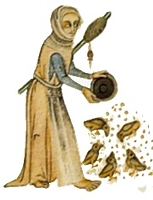 A
spindle was essentially nothing more than a slender, shaped stick
with a weight at the bottom called a whorl. The wool, already
cleaned and combed on the distaff was pried from the distaff onto
the spindle while it was manually spun. This produced a fine thread
which could then be woven into cloth. A
spindle was essentially nothing more than a slender, shaped stick
with a weight at the bottom called a whorl. The wool, already
cleaned and combed on the distaff was pried from the distaff onto
the spindle while it was manually spun. This produced a fine thread
which could then be woven into cloth.
The wooden distaff head shown at right is dated to the 15th century,
and was used for linen. It is 115mm tall and was found in Dordrecht.
The spindle whorl pictured at left comes from England and is made
from the bone of a cow's leg.
The image detail at left
is from the Luttrel Psalter, from the 14th century, and
shows a women with her spindle and distaff outside feeding the
chickens.

Spinning
Wheels
The late 13th century saw the introduction of the spinning wheel
into cloth production. The earliest illustration of a spinning
wheel in use is dated at 1237 from Baghdad.
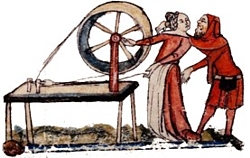 Originally,
the spinning wheel was set on a table and powered by hand, as
shown in the detail image from the 14th century manuscript, the
Luttrel Psalter. The image shows that the table is mounted
on wheels at one end, presumably to allow for the wheel to be
moved. Originally,
the spinning wheel was set on a table and powered by hand, as
shown in the detail image from the 14th century manuscript, the
Luttrel Psalter. The image shows that the table is mounted
on wheels at one end, presumably to allow for the wheel to be
moved.
At first, spinning wheels were not very well received because
the thread was rough and uneven and much better results were gained
spinning by hand. In 1280, it is recorded that the Draper's Guild
banned its use for this very reason.
Eventually, the spinning wheel produced better results, but according
the the 14th century Florentine book, Arte della Lana,
it was recommended that the shorter fibres of wool be saved for
use on the spinning wheel to make thread for the weft of a cloth,
and the longest fibres only used for hand spinning to make the
warp, which was where the fabric gained its strength.
During the 15th century, the foot pedal was added, leaving both
hands free to focus on the wool.

Looms
While a women was in charge of producing yarn for weaving on the
spindle or spinning wheel, the actual weaver of the household
was was usually the head male.
There were two styles of loom during the medieval period. The
early looms were upright, the later ones were horizontal. Upright
looms are still in use today for the manufacture of handmade tapestries.
Pictured at left is a detail manuscript by Boccaccio de Claris
Mulieribus showing a woman working at an upright loom.
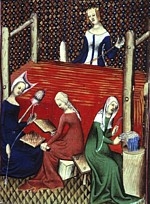 By
the 12th century, the horizontal loom had been mechanized and
was operated by foot-treadles. Instead of weaving the heddle bar
by hand, the weaver needed only to push the treadles and every
second warp thread rose above the others. By
the 12th century, the horizontal loom had been mechanized and
was operated by foot-treadles. Instead of weaving the heddle bar
by hand, the weaver needed only to push the treadles and every
second warp thread rose above the others.
The next push of the treadle lowered those and raised the next
set. The warp threads were rolled around a cylinder of wood at
the far end of the loom and unrolled as needed. The finished cloth
was gathered at the front of the loom.
By the 15th century, men's
domination over the weaving industry had waned and women were
also more regularly employed as weavers.
At the right is a detail from a 15th century image of Boccaccio's
de Claris Mulieribus. It shows the horizontal loom along
with the other steps necessary to produce the thread prior to
weaving- carding, spinning and cleaning.

Copyright
© Rosalie Gilbert
All text & photographs within this site are the property of
Rosalie Gilbert unless stated.
Art & artifact images remain the property of the owner.
Images and text may not be copied and used without permission.
|